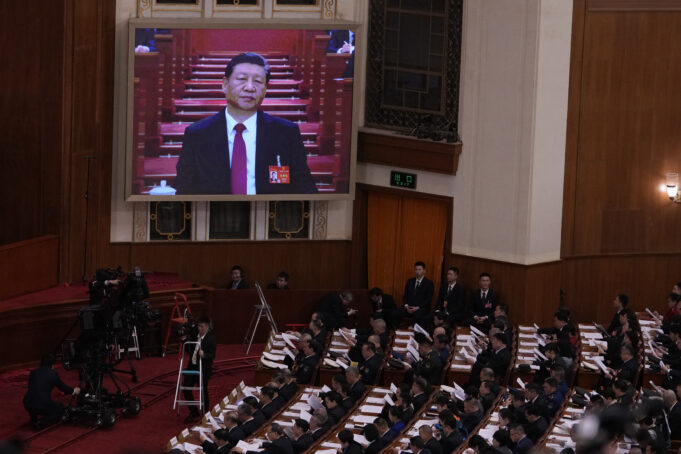BEIJING—China on March 5 announced a 7.2 percent increase in its defense budget, which is already the world’s second-highest behind the United States at 1.6 trillion yuan ($222 billion), roughly mirroring last year’s rise.
Tensions with the U.S., Taiwan, Japan and neighbors with competing claims to the crucial South China Sea are seen as furthering growth in high-tech military technologies from stealth fighters to aircraft carriers and a growing arsenal of nuclear weapons.
The official budget figure announced March 5 at the opening of the legislature’s annual meeting is considered only a fraction of spending by the People’s Liberation Army, the military wing of the ruling Communist Party, once spending on research and development and foreign weapons purchases are considered.
“We will provide stronger financial guarantees for efforts to modernize our national defense and the armed forces on all fronts and consolidate and enhance integrated national strategies and strategic capabilities,” Premier Li Qiang told the assembly of nearly 3,000 carefully selected participants, who showed overwhelming loyalty to the Communist Party and its leader, Xi Jinping.
China’s defense budget has more than doubled since 2015, even as the country’s economic growth rate has slowed considerably. However, the country’s continuing ambition is to challenge the U.S. and its allies in Asia including Japan, South Korea, the Philippines and Australia over territorial claims, regional leadership and a bigger say in world affairs.
Its defense budget grew by double-digit percentage figures for much of the 2000s but began to slow as the formerly booming economy started to plateau. In his address, Li put the GDP growth target at five percent this year, while acknowledging it would be difficult to achieve.
China’s economy is dealing with high youth unemployment and a cratering real estate market after developers who took out giant bank loans were unable to pay back their lenders or deliver units to buyers who had spent their life savings to put a roof over their heads.
That hasn’t dampened Beijing’s global ambitions, however, with conquest over the self-governing island democracy of Taiwan, driving Indian forces from their disputed border, and asserting control over islands in East China and South China Sea all on Beijing’s list of priorities.
In the latest dangerous incident, Chinese Coast Guard ships blocked Philippine vessels off a disputed South China Sea shoal on March 2, causing a minor collision, the Philippine Coast Guard said.
Philippine security officials have accused the Chinese coast guard and suspected militia ships of blocking Philippine vessels and using water cannons and a military-grade laser that temporarily blinded some Filipino crewmen in a series of high-seas hostilities last year.
Those all play into China’s increasingly intensive rivalry with the U.S. in the political, economic, military and technological spheres that has led to punitive tariffs and travel bans on Chinese officials, followed by retaliation by Beijing. China’s support for Russia and refusal to condemn its invasion of Ukraine has also aggravated relations with Washington.
The U.S. still leads the world in defense spending, with the Department of Defense’s proposed budget for fiscal year 2024 totaling $842 billion, roughly a five percent increase when adjusted for inflation.
While the U.S. has no official diplomatic relations with Taiwan, it remains the island’s main guarantor of security and provider of advanced weaponry.
The U.S. Navy announced that the guided-missile destroyer USS John Finn transited the Taiwan Strait dividing the island from mainland China on Tuesday, an act China frequently protests, along with the presence of U.S. Navy ships and planes elsewhere in the South China Sea.
“U.S. ships transit between the South China Sea and the East China Sea via the Taiwan Strait and have done so for many years,” the 7th Fleet said in a statement.
“The transit occurred through a corridor in the Taiwan Strait that is beyond any coastal state’s territorial seas. Within this corridor all nations enjoy high-seas freedoms of navigation, overflight, and other internationally lawful uses of the sea related to these freedoms,” it said.
The spokesperson for the PLA’s Eastern Theater Command, army Col. Shi Yi, accused the U.S. of “publicly hyping up” the passage of the ship and said Chinese naval and air forces tracked and monitored its progress.
“Troops in the theater are always on high alert and ready to respond to all threats and provocations,” Shi said on the Defense Ministry’s website.
According to the World Bank, China’s defense spending equaled 1.6 percent of its GDP in 2022, the last year for which figures were available, compared to 3.5 percent for the United States. While the U.S. defense budget has declined to about 12 percent of government spending, the proportion China spends remains obscure because of the many civilian-military collaboration projects it runs, from technology to business and real estate.
China also sends ships and planes near Taiwan on a daily basis in an attempt to wear down the equipment and morale of the Taiwanese armed forces and underline its threat that Taiwan must inevitably be united with the mainland, by force if necessary. (AP)













